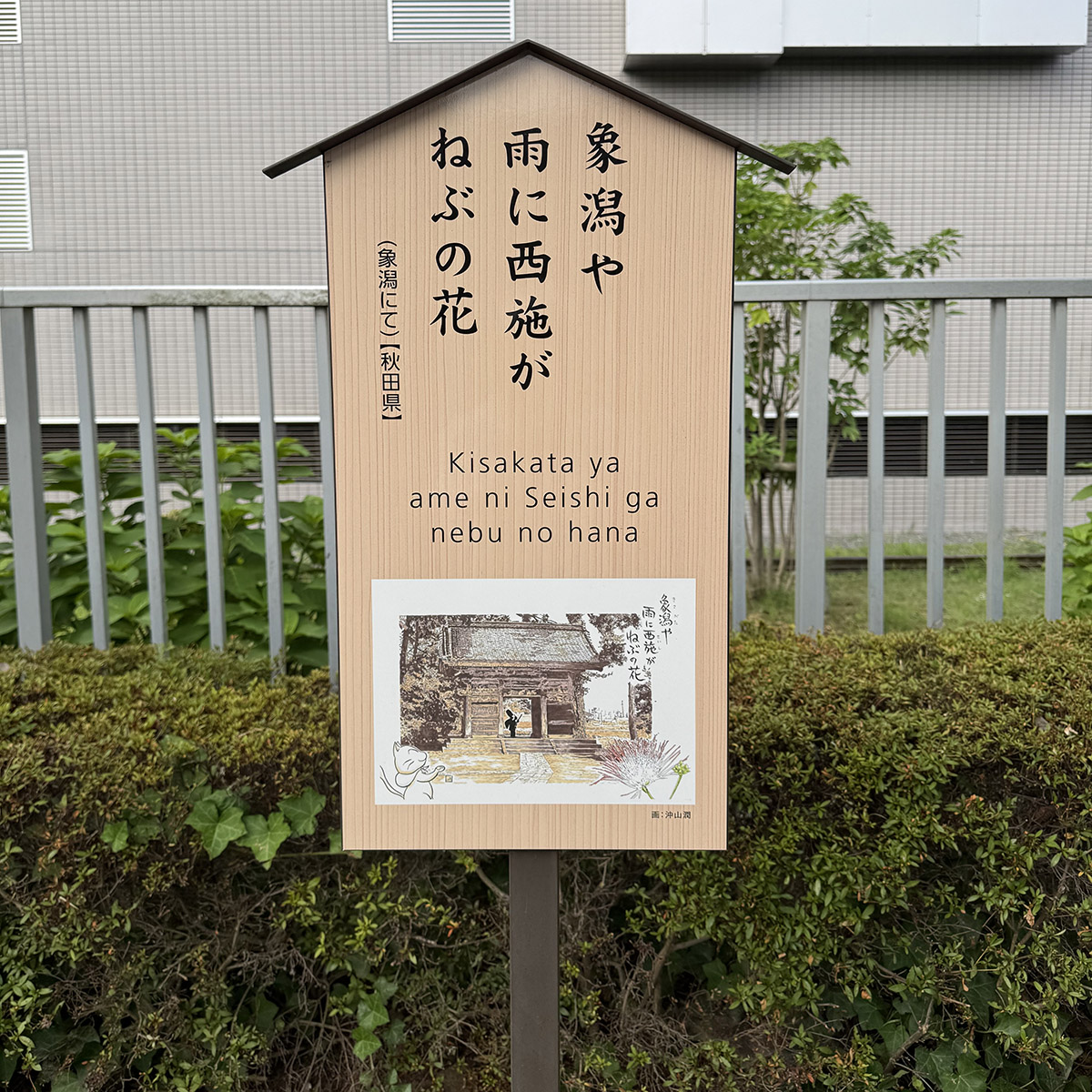September 12, 2025
Basho Haiku Walkway #02
In Oku no Hosomichi (The Narrow Road to the Deep North), Matsuo Basho journeyed through the rugged landscapes of northern Japan, capturing fleeting moments in haiku. Each poem is more than just a snapshot of nature; it reflects history, beauty, and the traveler’s own solitude.In this installment, we follow Basho through Akita and Yamagata, where coastal lagoons, rushing rivers, and towering clouds leave lasting impressions. These three haiku not only depict the landscapes of northern Japan but also showcase Basho’s talent for turning them into timeless expressions of human experience.
Haiku 4. Location: Kisakata, Akita Prefecture
In Kisakata,
rain falls—like Xi Shi’s grace,
on the silk tree blossoms.

Behind the Haiku - Discover the hidden stories behind each haiku -
1. The setting: KisakataBasho visited Kisakata, a scenic coastal area in today’s Akita Prefecture, during his journey in Oku no Hosomichi. At that time, Kisakata was famous for its lagoon dotted with small islets, often compared to the beauty of Matsushima in northern Japan. Even in the rain, the scenery had a quiet elegance that deeply moved Basho.
2. The flower of the silk tree (Albizia, “nebu”)
The “nebu” refers to the silk tree (Albizia julibrissin), whose delicate pink blossoms resemble fluffy fans or soft clouds. These flowers bloom in early summer, drooping slightly as if drowsy, which is why the tree is also called the “sleeping tree.” Their fragile beauty, especially when dampened by summer rain, evoked a refined sense of melancholy for Basho.
3. The allusion to Xi Shi
Xi Shi (西施) was one of the legendary Four Beauties of ancient China, renowned for her grace that could even cause fish to sink from shame. Basho likens the rain-soaked silk tree blossoms to Xi Shi’s beauty, transferring an image of timeless elegance onto a fleeting natural scene. In this way, the haiku fuses Chinese classical imagery with the Japanese landscape before him.
Basho’s vision
Rather than simply depicting flowers in the rain, Basho elevates the moment by weaving together nature, Chinese literary tradition, and his own sense of aesthetic perception. The rain softens the scene of Kisakata, and the blossoms appear imbued with Xi Shi’s legendary refinement. For the traveler-poet, it was a moment where the natural world and classical memory overlapped, leaving an impression of grace amidst solitude.
Haiku 5. Location: Sakata, Yamagata Prefecture
On this scorching day,
the Mogami River pours
straight into the sea.

Behind the Haiku - Discover the hidden stories behind each haiku –
1. The setting: Sakata and the Mogami RivereBasho arrived in Sakata, a prosperous port town in Yamagata Prefecture, where the Mogami River flows into the Sea of Japan. Known for its swift currents, the Mogami River was celebrated in many poems of the classical anthology Shin Kokin Wakashū. It was also vital for rice transport, making Sakata one of the great commercial hubs of northern Japan during Basho’s time.
2. The imagery of summer heat
The phrase atsuki hi (“scorching day”) conveys the intensity of midsummer. Basho captures not only the physical heat but also the heavy, pressing atmosphere of the season. The river, endlessly flowing into the sea, becomes a symbol of release and movement, as though it could carry away the stifling heat itself.
3. The dynamic movement of nature
In this haiku, the Mogami River is not just a geographical feature but an active force. Its rapid current seems to pour the very heat of the day into the vast, cooling sea. Basho transforms the simple landscape into a vivid metaphor, blending physical sensation with natural movement.
Basho’s vision
By uniting the burning heat, the rushing Mogami, and the expanse of the sea, Basho creates an image that is both immediate and timeless. For the traveler-poet, it was a moment of relief, where oppressive summer heat found its outlet in nature’s great cycle. The poem embodies Basho’s gift of turning ordinary sensations into a universal expression of human experience.
Haiku 6. Location: Minamidani Betsuin, Yamagata Prefecture
Towering clouds—
breaking into pieces,
the mountain of the moon.

Behind the Haiku - Discover the hidden stories behind each haiku –
1. The setting: Minamidani BetsuinThis haiku was composed when Basho visited Minamidani Betsuin, a temple in Yamagata Prefecture. Nestled in the mountains, the temple offered Basho a view of summer skies and the surrounding peaks. Such temples were often places of rest and reflection for travelers, allowing moments of quiet observation of nature.
2. Clouds and the summer season
The phrase kumo no mine (“cloud peaks”) refers to massive summer cumulus clouds rising like mountain ranges in the sky. In Japanese poetic tradition, these towering clouds often embody the height of summer, carrying both grandeur and impermanence.
3. The “mountain of the moon”
Basho then contrasts the clouds with tsuki no yama, “the mountain of the moon.” This is a metaphor for the mountain now bathed in moonlight, revealed as the clouds crumble and drift apart. The image suggests the shift from day’s heat and turbulence to the serenity of night, where the moon emerges beyond the vanishing clouds.
Basho’s vision
The poem captures a fleeting transformation: the mighty summer clouds rise and collapse, clearing the way for the moonlit mountain. In this single moment, Basho unites the turbulence of nature with the stillness of night. It is a meditation on change and transience — the grandeur of the clouds dissolves into emptiness, leaving behind the quiet, eternal glow of the moon.Conclusion
Through these verses, we see Basho weaving together the natural and the eternal. A lagoon softened by rain becomes the stage for legendary beauty; a mighty river seems to carry away the weight of summer heat; clouds dissolve to reveal a moonlit mountain. Each moment is transient, yet in Basho’s words, it becomes eternal.For the traveler-poet, these haiku were not just records of his journey but revelations of life’s impermanence and grandeur. For us, centuries later, they remain windows into the spirit of northern Japan — where land, sea, and sky merge into poetry.
Next in the Journey
In the next installment, we will present three more haiku:- Haiku 7 — composed in Ōishida, Yamagata Prefecture
- Haiku 8 — composed at Risshaku-ji (Yamadera), Yamagata Prefecture
- Haiku 9 — composed at the barrier gate of Shitomae, Yamagata Prefecture








